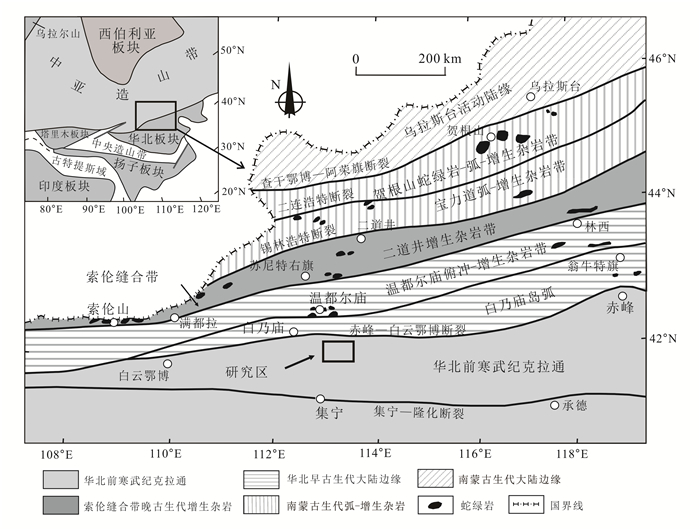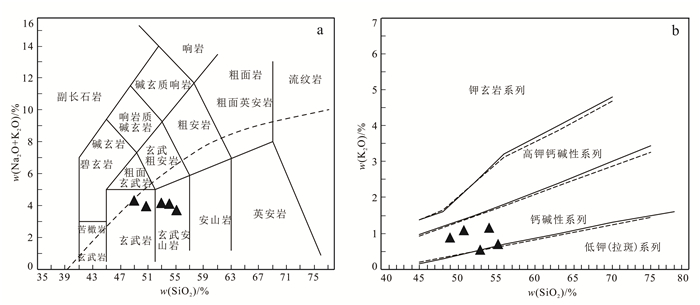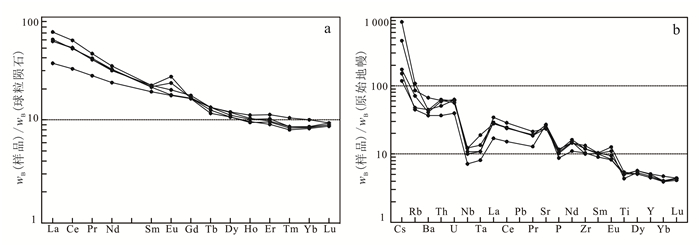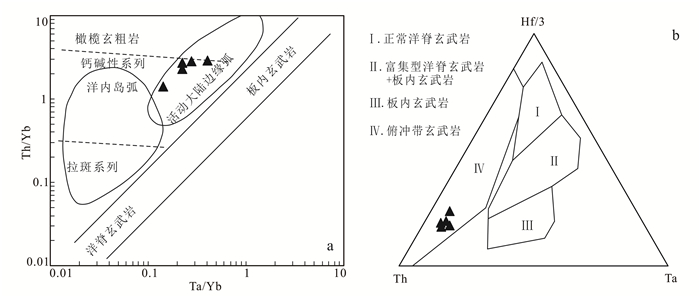0 引言
中亚造山带是位于西伯利亚板块和华北板块之间的一条巨大的增生型造山带,也是全球范围内显生宙增生最为强烈的地区之一[1-2]。兴蒙造山带隶属于中亚造山带东段[3-4],自早古生代以来经历俯冲、碰撞、造山带垮塌等演化过程[5],是目前已知时间最长、构造-岩浆演化最为复杂的造山带,长期以来一直作为研究华北板块和西伯利亚板块演化历史的重要窗口,并受到大量学者的广泛关注[6-9]。
岩浆作为板块活动中物质与能量交换的载体,其形成、分布和演化与构造环境密切相关,常用来恢复古大地构造环境[10]。而古亚洲洋的裂解-扩张-消亡和汇聚大陆边缘的俯冲-碰撞-伸展,这一系列演化过程留下了大量的岩浆记录,在二叠纪—早三叠世期间岩浆活动尤为活跃[11-12]。这些岩浆记录,都是确定古亚洲洋闭合时限及最终闭合位置的重要依据。兴蒙造山带构造演化复杂,经历时间较长,中外学者对其进行了半个多世纪的研究,至今,大多数学者认为最终碰撞及缝合位置为索伦缝合带[8, 13-16],但对于西伯利亚板块和华北板块的碰撞时限问题却没有达成一致,目前主要有两种观点:部分学者认为碰撞发生在泥盆纪或是中晚泥盆世—早石炭世[17-19];另一部分则认为碰撞发生在二叠纪—早三叠世初[6, 10, 16, 20-23]。
内蒙古中部广泛发育火山熔岩以及火山碎屑岩,尤其在二叠纪[24],这些都是研究古亚洲洋闭合位置及时限的重要依据。前人对大石寨组的火山岩进行了大量的地质年代学和岩石地球化学研究,但对其时代归属、成因以及构造背景还存在争议[25-27]。本文所研究的苏吉组安山岩,在岩性上与大石寨组类似,出露位置与前者分布在西拉木伦河带两侧[24, 28];但前人对苏吉组安山岩的研究却不如大石寨组广泛,缺少具体的年龄数据,而且对地球化学特征、形成的构造背景等问题也没有进行深入的研究。为此,本文在区调修测的基础上,结合野外产状、锆石LA-ICP-MS年代学研究和地球化学特征等,进一步确定了其形成年代和构造背景,为兴蒙造山带北部晚古生代构造演化、华北板块与西伯利亚板块碰撞等大地构造演化历史提供新的依据。
1 地质背景及样品采集研究区位于内蒙古自治区乌兰察布盟中北部和锡林郭勒盟西南一隅,土牧尔台镇附近,地处内蒙古高原上,地势相对平坦。大地构造位置位于中亚造山带东南段、华北板块北缘,临近华北板块与西伯利亚板块的交汇地带(图 1)。研究区中生代之前主要受古亚洲洋构造体系的影响,是研究古亚洲洋演化的重要区域。研究区主要出露古生代及其之前地层,主要为白云鄂博群、阿牙登组、拴马桩组和苏吉组,多数地层受岩浆活动和构造运动破坏,或被新生代地层严重覆盖,出露不完整,往往不见其顶底;新生界出露比较广泛(图 2)。其中,苏吉组为一套晚古生代陆相火山-沉积地层。在本测区内,该组分布较零星,主要沿东乌素—爱国村—西井子—屯垦队一带呈东西向分布。其整体与中下奥陶统阿牙登组呈断层接触,下部与二叠系拴马桩组呈不整合接触。由于岩性差异,将其自下而上分成2个岩性段:第一段主要由偏基性的角闪安山岩组成,分布较局限;第二段由酸性的英安-流纹质火山碎屑岩、英安岩、流纹岩组成。两者零散分布于研究区方家沟附近,呈北东向延伸。其中,第二段出露面积较大,并且被早二叠世花岗斑岩和中二叠世花岗岩侵入(图 3)。
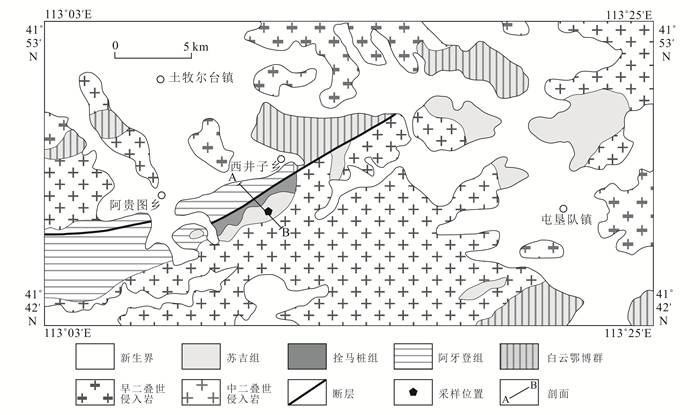
|
| 图 2 研究区地质简图 Figure 2 Regional geological map of the study area |
|
|

|
| 图 3 苏吉组实测剖面图 Figure 3 Measured section of Suzy Formation |
|
|
本文主要对位于爱国村附近的苏吉组一段安山岩进行研究。采集了数块安山岩标本,一类为杏仁安山岩(图 4a,b):风化面为浅黑色,新鲜面为灰黑色,斑状结构,块状构造;镜下岩石为斑状结构,块状构造,杏仁构造;斑晶为斜长石和普通辉石;基质为细板条状斜长石微晶,杂乱分布,其内充细粒镁铁矿物和磁铁矿,但镁铁矿物已被绿泥石化角闪石取代,它们与斜长石微晶一起构成间粒结构;杏仁为细粒碳酸盐集合体和石英集合体。另一类为角闪安山岩(图 4c,d):风化面为浅黑灰色,新鲜面为黑灰色,肉眼可见明显的交织结构,块状构造,可见少量的角闪石斑晶,体积分数小于5%,粒度小于1 mm;镜下岩石为斑状结构,基质为交织结构;斑晶体积分数为20%~25%,主要成分为斜长石和普通角闪石,部分普通角闪石发生阳起石化;基质为细板条状斜长石微晶,近平行排列,内充填细小微晶和细粒磁铁矿构成交织结构。
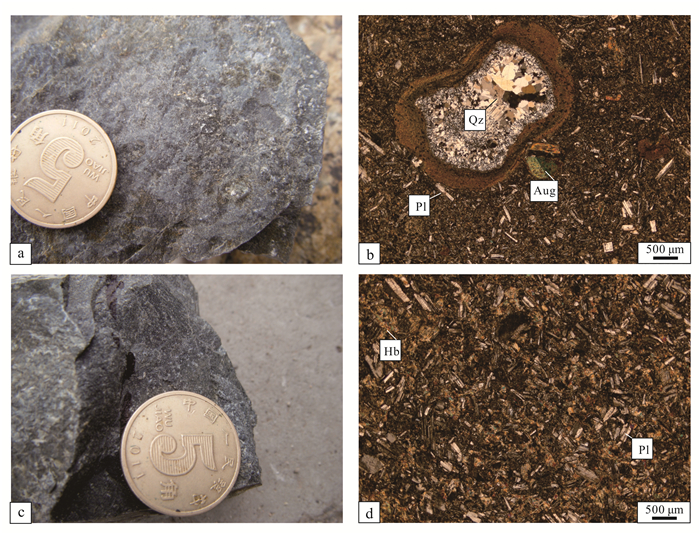
|
| Qz.石英;Pl.斜长石;Aug.普通辉石;Hb.普通角闪石。 图 4 杏仁安山岩(a,b)和角闪安山岩(c,d)的野外和镜下照片 Figure 4 Specimen photos and photomicrographs of the amygdaloidal andesite(a, b) and hornblende andesite(c, d) |
|
|
野外采集5块角闪安山岩样本,对其进行全岩的主量和微量元素分析,选取其中的一块较为新鲜且体积较大的角闪安山岩样本G3117-12进行锆石LA-ICP-MS U-Pb定年研究。
在河北省廊坊市区域地质调查所实验室进行了锆石挑选,中国地质科学院地质研究所北京离子探针中心进行制靶和阴极发光(CL)图像的采集,锆石U-Pb同位素分析在中国地质科学院矿产资源研究所国土资源部成矿作用与资源评价重点实验室完成。测试由带有多个离子计数器的Finnigan Neptune型多接收电感耦合等离子体质谱仪(MC-ICP-MS)及与之配套的New wave UP 213激光剥蚀系统联机进行。MC-ICP-MS激光器剥蚀采样采用单点剥蚀的方式,实验中采用He气作为剥蚀物质的载气, 用213 nm激光器对锆石进行剥蚀的深度为20~40 μm,激光剥蚀斑束直径25 μm。用锆石GJ-1作为外部锆石年龄标准进行分馏校正,元素含量则采用玻璃标样NIST 612作为外标[30]。锆石标样采用GJ-1标准锆石,数据处理采用中国地质大学刘勇胜编写的ICPMSDateCal程序[31],加权平均年龄计算及协和图的绘制采用Isoplot[32],其置信度为95%。整个数据处理过程中,采用208Pb对普通铅进行校正,利用NIST612玻璃标样计算锆石样品的Pb、U、Th含量。具体测试方法、详细分析步骤见文献[33]。
岩石化学分析在国家地质实验测试中心完成,主量元素采用ICP-AES(原子发射光谱), LOI为1 000 ℃烧蚀;稀土元素中的La、Ce采用ICP-AES, 其他元素采用ICP-MS;微量元素中的Sc、Sr、Ba采用ICP-AES,Nb、Rb、Zr、Cr、V、Co、Th、Hf、Ta、U采用ICP-MS。
3 锆石特征及分析结果本文对出露于商都县土牧尔台地区的苏吉组安山岩的样品进行了LA-ICP-MS U-Pb定年,岩性为角闪安山岩,采样位置如图 2所示。
安山岩中的锆石自形程度较好,呈自形至半自形,长20~120 μm,以长柱状或短柱状为特征,长宽比例为1: 1~1: 2,晶型保存较完好,阴极发光图片上可明显见到震荡环带结构(图 5),个别看似具有核幔构造。实验测得30颗锆石的数据点(表 1),U、Th质量分数的范围分别为204×10-6~717×10-6、125×10-6~760×10-6,其Th/U值为0.61~1.06,都大于0.60,为典型的岩浆成因锆石 。其中:有6颗锆石的谐和度较低,且CL图像上位置亮白,可能是测试过程中Pb丢失造成的;有2个锆石点年龄偏低,可能为后期岩浆热液锆石。其余22个测试点数据集中在谐和线附近,给出了非常集中的206Pb/238U年龄,谐和年龄为(278.9±1.1) Ma,加权平均年龄为(279.0±2.1) Ma(图 6),代表了火山岩的喷发年龄。
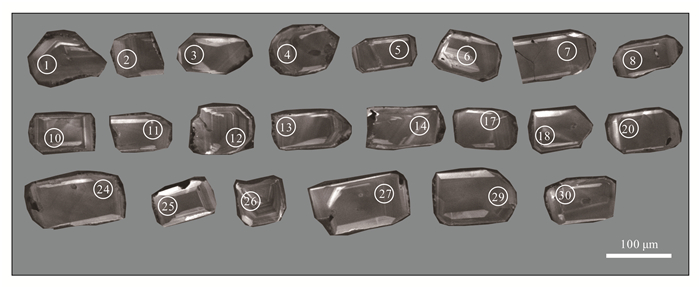
|
| 图 5 锆石阴极发光代表性照片 Figure 5 CL imaging of zircons fromhornblende andsesites of Suzy Formation |
|
|
| 样品号G3117-12 | wB/10-6 | Th/U | 同位素比值 | 年龄/Ma | |||||||||||
| Pb | Th | U | 207Pb/206Pb | σ | 207Pb/235U | σ | 206Pb/238U | σ | 207Pb/235U | σ | 206Pb/238U | σ | |||
| 1 | 21 | 378 | 440 | 0.86 | 0.052 16 | 0.002 74 | 0.309 79 | 0.015 80 | 0.043 59 | 0.000 85 | 274 | 12 | 275 | 5 | |
| 2 | 20 | 352 | 416 | 0.85 | 0.052 39 | 0.002 78 | 0.313 44 | 0.015 97 | 0.043 99 | 0.000 73 | 277 | 12 | 278 | 5 | |
| 3 | 19 | 316 | 390 | 0.81 | 0.054 67 | 0.003 26 | 0.326 88 | 0.019 37 | 0.043 75 | 0.000 77 | 287 | 15 | 276 | 5 | |
| 4 | 27 | 526 | 536 | 0.98 | 0.051 86 | 0.002 77 | 0.310 79 | 0.016 78 | 0.043 73 | 0.000 61 | 275 | 13 | 276 | 4 | |
| 5 | 23 | 448 | 464 | 0.97 | 0.048 65 | 0.002 62 | 0.293 60 | 0.015 34 | 0.044 35 | 0.000 69 | 261 | 12 | 280 | 4 | |
| 6 | 15 | 214 | 321 | 0.67 | 0.056 27 | 0.003 59 | 0.334 48 | 0.020 15 | 0.044 56 | 0.000 86 | 293 | 15 | 281 | 5 | |
| 7 | 20 | 379 | 397 | 0.95 | 0.053 18 | 0.003 00 | 0.325 94 | 0.018 34 | 0.044 38 | 0.000 77 | 286 | 14 | 280 | 5 | |
| 8 | 14 | 231 | 294 | 0.79 | 0.050 85 | 0.003 12 | 0.308 58 | 0.018 30 | 0.044 40 | 0.000 78 | 273 | 14 | 280 | 5 | |
| 9 | 18 | 305 | 392 | 0.78 | 0.052 80 | 0.004 80 | 0.308 08 | 0.039 05 | 0.040 90 | 0.001 54 | 273 | 30 | 258 | 10 | |
| 10 | 20 | 331 | 401 | 0.83 | 0.048 53 | 0.004 44 | 0.292 18 | 0.022 74 | 0.044 38 | 0.001 07 | 260 | 18 | 280 | 7 | |
| 11 | 20 | 373 | 399 | 0.94 | 0.060 57 | 0.004 71 | 0.359 19 | 0.024 88 | 0.044 10 | 0.000 85 | 312 | 19 | 278 | 5 | |
| 12 | 24 | 394 | 485 | 0.81 | 0.053 16 | 0.003 66 | 0.320 12 | 0.021 28 | 0.043 94 | 0.000 80 | 282 | 16 | 277 | 5 | |
| 13 | 18 | 276 | 372 | 0.74 | 0.058 25 | 0.004 63 | 0.343 85 | 0.024 78 | 0.044 42 | 0.001 03 | 300 | 19 | 280 | 6 | |
| 14 | 12 | 172 | 252 | 0.68 | 0.059 68 | 0.005 46 | 0.358 74 | 0.032 04 | 0.043 86 | 0.000 90 | 311 | 24 | 277 | 6 | |
| 15 | 17 | 225 | 325 | 0.69 | 0.089 09 | 0.007 71 | 0.523 64 | 0.042 81 | 0.043 85 | 0.000 96 | 428 | 29 | 277 | 6 | |
| 16 | 15 | 250 | 347 | 0.72 | 0.080 32 | 0.013 35 | 0.430 82 | 0.063 93 | 0.039 24 | 0.001 93 | 364 | 45 | 248 | 12 | |
| 17 | 17 | 273 | 360 | 0.76 | 0.053 56 | 0.003 45 | 0.327 19 | 0.021 05 | 0.044 61 | 0.000 71 | 287 | 16 | 281 | 4 | |
| 18 | 15 | 212 | 307 | 0.69 | 0.056 99 | 0.005 36 | 0.339 59 | 0.026 98 | 0.044 69 | 0.001 00 | 297 | 20 | 282 | 6 | |
| 19 | 9 | 125 | 204 | 0.61 | 0.078 36 | 0.011 80 | 0.429 10 | 0.059 05 | 0.414 44 | 0.001 28 | 363 | 42 | 262 | 8 | |
| 20 | 37 | 760 | 717 | 1.06 | 0.047 65 | 0.003 34 | 0.288 93 | 0.020 07 | 0.044 11 | 0.000 67 | 258 | 16 | 278 | 4 | |
| 21 | 16 | 212 | 311 | 0.68 | 0.078 05 | 0.010 44 | 0.473 17 | 0.061 13 | 0.044 70 | 0.001 43 | 393 | 42 | 282 | 9 | |
| 22 | 18 | 252 | 390 | 0.65 | 0.058 67 | 0.009 66 | 0.345 94 | 0.058 79 | 0.040 64 | 0.001 45 | 302 | 44 | 269 | 9 | |
| 23 | 21 | 375 | 384 | 0.98 | 0.074 11 | 0.009 95 | 0.462 45 | 0.059 97 | 0.046 71 | 0.001 80 | 386 | 42 | 294 | 11 | |
| 24 | 21 | 362 | 408 | 0.89 | 0.051 82 | 0.007 20 | 0.317 79 | 0.044 64 | 0.044 96 | 0.001 28 | 280 | 34 | 283 | 8 | |
| 25 | 19 | 270 | 397 | 0.68 | 0.058 72 | 0.004 65 | 0.350 92 | 0.023 59 | 0.044 35 | 0.000 95 | 305 | 18 | 280 | 6 | |
| 26 | 20 | 318 | 419 | 0.76 | 0.051 24 | 0.003 83 | 0.313 00 | 0.022 94 | 0.044 50 | 0.000 76 | 277 | 18 | 281 | 5 | |
| 27 | 19 | 266 | 402 | 0.66 | 0.054 83 | 0.005 40 | 0.332 16 | 0.031 39 | 0.044 33 | 0.001 20 | 291 | 24 | 280 | 7 | |
| 28 | 13 | 212 | 321 | 0.66 | 0.566 14 | 0.008 87 | 0.325 66 | 0.051 77 | 0.041 96 | 0.001 93 | 286 | 40 | 265 | 12 | |
| 29 | 18 | 278 | 388 | 0.72 | 0.053 93 | 0.003 99 | 0.331 94 | 0.024 86 | 0.044 44 | 0.000 90 | 291 | 19 | 280 | 6 | |
| 30 | 21 | 369 | 423 | 0.87 | 0.055 68 | 0.006 34 | 0.344 40 | 0.038 50 | 0.044 73 | 0.000 92 | 300 | 29 | 282 | 6 | |
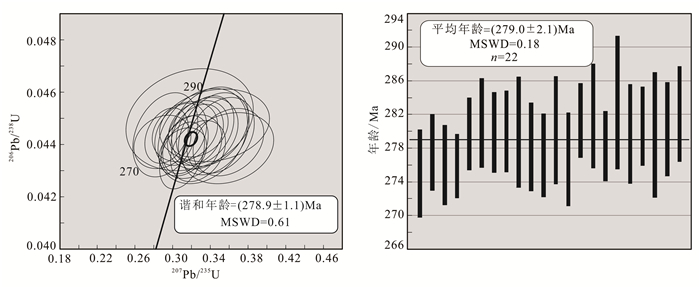
|
| 图 6 苏吉组角闪安山岩中的LA-ICP-MS锆石U-Pb谐和图 Figure 6 Concordia diagram showing LA-ICP-MS zircon U-Pb dating results ofhornblende andsesites in Suzy Formation |
|
|
本次工作采集的岩石地球化学分析样品共有5件,采样位置如图 2所示。岩性为1块杏仁玄武安山岩、1块安山岩、3块角闪安山岩,岩石均为新鲜样品,切除表面后粉碎,并挑出包体。
4.1 主量元素本区岩石样品的地球化学数据见表 2。其中:SiO2质量分数变化范围较小,为49.0%~55.2%,均值52.4%,属于基性-中基性岩;Al2O3质量分数为15.70%~17.80%,均值16.56%;K2O质量分数为0.53%~1.16%,均值0.87%;Na2O质量分数为2.88%~3.60%,均值3.16%;MgO质量分数为4.56%~8.29%,均值6.77%;TiO2质量分数为0.87%~1.08%,均值1.00%;P2O5质量分数为0.18%~0.24%,均值0.22%;w(K2O+Na2O)=3.69%~4.30%,均值4.03%;σ指数为1.12~3.08,均值1.89;TFeO为6.81%~9.19%,均值7.90%;Mg#为49.84~67. 02,均值60. 12;铝饱和指数(Al2O3/(CaO+K2O+Na2O))为0.71~0.95,均值0.79,为偏铝质岩石。在TAS图解(图 7a)中,2件落到玄武岩区,另外3件落到玄武安山岩区,且基本都落在亚碱性区域;在w(K2O)-w(SiO2)图解(图 7b)中,岩石样品具有钙碱性及低钾(拉斑)玄武岩性岩石系列特征。
| 样品号 | SiO2 | Al2O3 | Fe2O3 | CaO | MgO | K2O | Na2O | TiO2 | MnO | P2O5 | 烧失量 | 总和 | Mg# | K2O+Na2O | A/CNK | La | Ce | Pr | Nd | Sm | Eu | Gd | Tb | Dy | Ho | Er | Tm | Yb | Lu | Y | Rb | Sr | Ba | U | Th | Nb | Ta | Zr | Cr | V | Hf | ∑REE | ΣLREE/ΣHREE | (La/Yb)N | δEu |
| G3117-8 | 50.8 | 16.60 | 8.16 | 8.61 | 8.29 | 1.09 | 2.88 | 1.02 | 0.14 | 0.24 | 1.99 | 100.10 | 67.02 | 3.97 | 0.77 | 18.0 | 40.3 | 4.69 | 18.5 | 4.06 | 1.29 | 4.20 | 0.59 | 3.44 | 0.69 | 1.90 | 0.26 | 1.72 | 0.28 | 19.2 | 51.2 | 537 | 440 | 1.12 | 4.89 | 7.9 | 0.7 | 125 | 590 | 181 | 3.5 | 99.92 | 6.64 | 7.51 | 0.95 |
| G3117-9 | 54.1 | 15.70 | 7.57 | 8.20 | 7.58 | 1.16 | 2.92 | 1.02 | 0.11 | 0.21 | 1.63 | 100.45 | 66.70 | 4.08 | 0.75 | 18.1 | 40.8 | 4.69 | 18.1 | 4.21 | 1.44 | 4.46 | 0.63 | 3.83 | 0.74 | 2.05 | 0.28 | 1.79 | 0.30 | 21.4 | 64.8 | 476 | 292 | 1.20 | 4.98 | 8.1 | 0.5 | 139 | 480 | 179 | 3.8 | 101.42 | 6.20 | 7.25 | 1.01 |
| G3117-10 | 55.2 | 15.85 | 9.18 | 9.18 | 4.56 | 0.69 | 3.00 | 0.87 | 0.15 | 0.22 | 0.76 | 99.85 | 49.84 | 3.69 | 0.71 | 18.7 | 39.7 | 4.83 | 18.7 | 4.12 | 1.68 | 4.27 | 0.63 | 3.60 | 0.73 | 2.16 | 0.28 | 1.78 | 0.29 | 20.3 | 28.5 | 525 | 294 | 1.24 | 4.06 | 6.6 | 0.4 | 105 | 160 | 194 | 2.9 | 101.47 | 6.39 | 7.54 | 1.21 |
| G3117-11 | 49.0 | 17.80 | 10.22 | 6.70 | 7.44 | 0.88 | 3.42 | 1.08 | 0.11 | 0.23 | 2.55 | 99.71 | 59.29 | 4.30 | 0.95 | 22.2 | 47.8 | 5.38 | 20.1 | 4.21 | 1.93 | 4.17 | 0.55 | 3.43 | 0.68 | 2.00 | 0.27 | 1.76 | 0.29 | 19.2 | 42.5 | 462 | 269 | 1.26 | 4.71 | 7.1 | 0.4 | 125 | 710 | 221 | 3.5 | 114.77 | 7.73 | 9.05 | 1.39 |
| G3117-12 | 52.9 | 16.85 | 8.76 | 8.76 | 5.99 | 0.53 | 3.60 | 1.00 | 0.16 | 0.18 | 1.02 | 99.93 | 57.77 | 4.13 | 0.75 | 11.0 | 25.3 | 3.28 | 13.8 | 3.68 | 1.27 | 4.17 | 0.63 | 3.84 | 0.80 | 2.36 | 0.34 | 2.09 | 0.30 | 21.8 | 26.8 | 534 | 240 | 0.79 | 2.94 | 4.7 | 0.3 | 109 | 150 | 197 | 3.0 | 72.86 | 4.01 | 3.78 | 0.99 |
| 注:主量元素质量分数单位为%;微量元素质量分数单位为10-6。 | |||||||||||||||||||||||||||||||||||||||||||||
稀土元素组成测试结果见表 2。所采集的样品w(ΣREE)=72.86×10-6~114.77×10-6,均值98.09×10-6,稀土总量较低;LREE/HREE=4.01~7.73,均值6.19,轻稀土富集,重稀土亏损,(La/Yb)N=3.78~9.05, 均值7.02,轻重稀土分异较强;样品稀土元素分配模式呈现LREE富集、HREE亏损的右倾型,大部分互相重合叠加或平行排列。δEu变化范围为0.95~1.39,均值1.11,呈弱Eu正异常(图 8a);(La/Sm)N=1.93~3.40,均值2.78,(Eu/Yb)N=1.78~3.21,均值2.46,轻重稀土各自的分馏程度相似。
微量元素原始地幔标准化蛛网图中,苏吉组火山岩具有较一致的曲线形式(图 8b),大离子亲石元素LILE(Cs、Ba、Sr)明显富集,明显亏损高场强元素HFSE(Nb、Ti、Ta)。
5 讨论 5.1 华北板块北缘二叠纪火山岩的形成时代前人根据地层对比和上下层位的相对时间,以及苏吉组中侵入岩的时代,将该地区苏吉组火山岩定为早二叠世晚期,长久以来,对该组火山岩的研究缺少相应的测年证据。本文所研究的安山岩,其中的锆石结构和Th/U值都符合岩浆成因标准,因此所测年龄应代表安山岩的形成时代。除本文所研究的区域之外,在华北板块北缘早二叠世存在着大规模的岩浆活动,由西至东均有分布:乌拉特中旗黑云母二长花岗岩((279±3) Ma)[40],白云鄂博花岗闪长岩((269±3) Ma)、黑云母花岗岩((268±2) Ma)[41],达茂旗正长花岗岩((268±2) Ma)、花岗岩((264±2) Ma)[42],四子王旗正长花岗岩((264±3) Ma)、黑云母花岗闪长岩((267±9) Ma)[11],集宁地区石英闪长岩((272±2) Ma)、花岗闪长岩((271±1) Ma,(269±1) Ma)[43],承德地区闪长岩((288±2) Ma)[44],赤峰西营子英云闪长岩((278±3) Ma[45],西乌旗地区辉长岩((275±2) Ma)[46]。这些资料都有力地证明了,在早二叠世,华北板块北缘存在广泛的岩浆事件。
5.2 岩浆源区土牧尔台地区火山岩的5块安山岩样品,具有w(MgO)>5.00%(本文均值6.77%),TFeO/MgO<1.50(本文均值1.23),w(CaO)<10.00%(本文均值8.29%),类似于高镁安山岩[47]。这其中岩石中较高的Mg#(本文均值60.12),明显大于下地壳铁镁质部分熔融的岩浆(Mg#<40.00)[48],并且有较高的Cr、Co、Ni等基性组分,也反映了火山岩具有地幔成因特征,而不是榴辉岩等下地壳岩石部分熔融的产物[49-50]。
另外,本文安山岩Rb/Sr为0.054~0.136,均值0.086,稍高于原始地幔(0.030)、富集型洋中脊E-MORB(0.033) 和洋岛玄武岩OIB(0.047);Nd/Th值为3.6~4.7,均值4.2,与壳源比值(3.0) 相近[51],近于中地壳;且苏吉组安山岩的Th质量分数(均值4.3×10-6)、U质量分数(均值1.1×10-6)也近于中地壳(w(Th)=6.5×10-6,w(U)=1.3×10-6),暗示可能与地壳物质的加入有关[52]。另外,La/Nb值也常用来判断地幔物质是否受到陆壳混染,本文所采集样品的La/Nb值为2.2~3.1,均值2.6,明显高于地幔(1.0),接近地壳值(2.2)[53],表明该基性岩源区有陆壳组分参与。
高镁安山岩通常与俯冲有关[47],而俯冲板片发生熔体交代的可能性比较小,因为其条件苛刻往往只发生在年轻的洋壳俯冲,或者有特殊的构造条件,而其他情况熔融很难发生[54],所以,源区更可能为俯冲流体交代的亏损岩石圈地幔或是陆壳物质[55],且有流体贡献的高镁安山岩一个显著的特点就是含有较高的重稀土元素含量[47],本文样品w(HREE)为(13.08~14.53)×10-6,均值13.72×10-6;另外,样品为过铝质岩石,说明源区可能受到俯冲板片携带的大洋沉积物改造。而俯冲流体交代常在岛弧方向形成拉斑玄武岩,在俯冲带内侧的大陆方向形成钙碱性高铝玄武岩、钾玄岩和碱性岩,通常的岩石组合为钙碱性玄武岩-安山岩-英安岩-流纹岩及相应侵入岩组合[56]。研究区苏吉组的这套岩石有很好的对应。
在Harker图解(图略)中,样品中随SiO2质量分数的增加,MgO、TiO2、TFeO、Al2O3质量分数有降低趋势,CaO质量分数有上升趋势,其余氧化物质量分数变化没有明显趋势;另外,在REE模式图中的轻微Eu正异常及Sr正异常;以上说明岩浆在演化过程中基本不存在分离结晶作用。在玄武岩岩浆分异的过程中,SiO2质量分数升高,Th/La和La/Sm增加程度小,地壳中三者含量都偏高,样品中w(SiO2)与Th/La和La/Sm部分数据有一定的相关性(图略),暗示基性岩浆偏离了封闭的分离结晶体系,并遭受一定陆壳混染[19]。综上所述,研究区的岩浆来自俯冲流体交代的亏损岩石圈地幔的部分熔融,在上升过程中伴随一定程度陆壳混染(图 9a)。这一结论与前人观点基本吻合。
华北板块北缘早石炭世晚期到中二叠世的中酸性侵入岩大多具有较低的初始87Sr/86Sr值(0.705~0.710) 及低的εNd(t)值(-17.1~-9.3) 与εHf (t)值(-38.3~-7.4);而与之相比,基性侵入岩87Sr/86Sr值要更低一些[12],这说明两者来源不同,基性岩更可能起源于岩石圈地幔的局部熔融。出露赤峰地区的玄武岩和玄武安山岩,显示出较低的初始87Sr/86Sr值(0.703 47~0.709 14),低负到近0的εNd(t)值(-10.4~0.7),以及负εHf(t)值(-16.2~-4.9),也说明了基性火山岩的幔源来源。其中,玄武安山岩具有相对玄武岩高的初始87Sr/86Sr值(0.709 14) 和较低的εNd(t)值(-10.4)[57],表明在岩浆上升途中受到地壳物质的混入。
而在研究区,甚至整个华北板块北缘的大部分区域,酸性岩出露的面积要远远大于基性岩,这也说明酸性岩不能全部来自铁镁质岩浆的分离结晶,它们大多数更有可能来自地壳,并且和铁镁质岩浆的底侵有关。对苏吉组火山岩中的酸性岩进行研究的结果也同样显示出,其古老的Hf二阶段模式年龄指示它们主要源自华北克拉通基底组分的部分熔融,在上升过程中也经历了不同程度的岩浆混合作用[58]。在研究区附近出露大量的花岗质岩石,这些岩石的年龄与本文所研究的玄武安山岩相近,如花岗闪长岩((271.4±1.3) Ma),在其中发现闪长质包体,包体的年龄与寄主岩石基本一致((268.5±1.3) Ma,未发表资料);并且其地球化学特征与研究区内的玄武安山岩相似[43],它们可能为同一来源。在中亚造山带北部西伯利亚板块南缘,也存在大面积的花岗岩包含基性包体的现象,有学者对其研究并提出了一种岩浆演化模式,笔者认为,该模式也可以对研究区的岩性分布和花岗质岩石里的基性包体做出合理解释[59],如图 9b所示:开始由俯冲流体交代的地幔楔的部分熔融产生了富水的玄武质岩浆,玄武质岩浆底侵到深部地壳,提供了热源,加之有流体加入,加速了下部地壳的熔融。结晶不完全的玄武质岩浆在上升过程中可能遭遇不同程度的岩浆混合作用,进而产生基性包体;那些混合作用较弱的基性岩浆可能以小范围的基性岩产出。只有少量基性岩浆能达到地壳浅部,这也就解释了地表少量基性岩和花岗质岩石里基性包体的成因。
5.3 构造背景及意义研究区火山岩为玄武安山岩、安山岩、英安岩和流纹岩及其碎屑岩组合,相关的侵入岩为花岗闪长岩和花岗斑岩,是典型的大陆边缘弧环境的火成岩组合[62],且相关的花岗质岩石属于钙碱性-高钾钙碱性、准铝质-过铝质系列,反映了典型的安第斯型活动大陆边缘特点[63]。研究区安山岩富集LILE、亏损HFSE,且具有较低的稀土元素总量和较平坦的稀土分配模式,这些特点常出现在岛弧火山岩中[64]。在Th/Yb-Ta/Yb构造判别图解(图 10a)中,本文所采集的标本都落在活动大陆边缘范围内;在Th-Hf/3-Ta图解(图 10b)中,样品同样落在了俯冲带玄武岩范围内。
根据苏吉组火山岩的喷出时间及构造背景,笔者认为,在早二叠世,西伯利亚板块和华北板块并未拼合,仍处于俯冲状态(图 9a)。与该区域相邻的早二叠世闪长岩也具有活动大陆边缘火山岩的特点,且中二叠世之后的花岗岩类有明显的后碰撞花岗岩属性[63];古地理和古生物证据也很好地证实了该观点,内蒙古中部二叠纪深水沉积中出现放射虫[66],说明二叠纪期间古亚洲洋依然存在;二叠纪沉积岩也有相应的证据,晚二叠世内蒙东部边缘发育有磨拉石建造及海陆交互相火山碎屑岩[67];在索伦缝合带北侧,二叠纪活动大陆边缘沉积建造中,对其中的碎屑锆石进行统计,发现有华北板块25亿a左右碎屑锆石[68],说明古亚洲洋仍然存在;同样位于索伦缝合带北侧的林西地区,一套类似的玄武安山岩也反映出活动大陆边缘的性质[69]。除此之外,高镁安山岩的产出,本身就与俯冲环境关系密切。综上所述,在早二叠世,古亚洲洋仍存在,华北板块北缘中部此时仍受古亚洲洋俯冲影响,且该地区属于安第斯型活动大陆边缘环境。
6 结论基于华北板块北缘中段苏吉组火山岩的锆石U-Pb年代学和岩石地球化学分析,结合区域演化历史,并和相邻地区出露的火山岩进行归纳对比, 笔者得出以下认识:
1) 土牧尔台地区苏吉组火山岩形成于早二叠世((279.0±2.1) Ma), 在早二叠世华北板块北缘有规模较大的岩浆活动。
2) 土牧尔台地区苏吉组火山岩形成于安第斯型活动大陆边缘环境,岩浆起源于受俯冲板片流体交代的亏损地幔,并受陆壳混染。
3) 在早二叠世,华北板块和西伯利亚板块仍未闭合,华北板块北缘处于古亚洲洋的俯冲状态下。
致谢: 野外工作得到杨振升教授的大力协助,在此致以衷心的感谢。| [1] | Windley B F, Alexeiev D, Xiao W, et al. Tectonic Models for Accretion of the Central Asian Orogenic Belt[J]. Journal of the Geological Society, 2006, 164(12): 31-47. |
| [2] |
肖文交, 舒良树, 高俊, 等. 中亚造山带大陆动力学过程与成矿作用[J].
新疆地质, 2008, 26(1): 4-8.
Xiao Wenjiao, Shu Liangshu, Gao Jun, et al. Continental Dynamcis of the Central Asian Orogenic Belt and Its Metallogeny[J]. Xinjiang Geology, 2008, 26(1): 4-8. |
| [3] | Sengör A M C, Natalin B A. Paleotectonics of Asia:Fragments of a Synthesis[M]. Translated by Yin A, Harrison M. London: Cambridge University Press London, 1996: 486-640. |
| [4] |
李双林, 欧阳自远. 兴蒙造山带及邻区的构造格局与构造演化[J].
海洋地质与第四纪地质, 1998, 18(3): 45-54.
Li Shuanglin, Ouyang Ziyuan. Tectonic Framework and Evolution of Xing'anling-Mongolian Orogenic Belt(XMOB) and Its Adjacent Region[J]. Marine Geology & Quaternary Geology, 1998, 18(3): 45-54. |
| [5] |
张晓晖, 翟明国. 华北北部古生代大陆地壳增生过程中的岩浆作用与成矿效应[J].
岩石学报, 2010, 26(5): 1329-1341.
Zhang Xiaohui, Zhai Mingguo. Magmatism and Its Metallogenetic Effects During the Paleozoic Continental Crustal Construction in Northern North China:An Overview[J]. Acta Petrologica Sinica, 2010, 26(5): 1329-1341. |
| [6] | Chen B, Jahn B M, Tian W. Evolution of the Solonker Suture Zone:Constraints From Zircon U-Pb Ages, Hf Isotopic Ratios and Whole-Rock Nd-Sr Isotope Compositions of Subduction-and Collision-Related Magmas and Forearc Sediments[J]. Journal of Asian Earth Sciences, 2009, 34(3): 245-257. DOI:10.1016/j.jseaes.2008.05.007 |
| [7] | Xu M A, Chen B, Chen J F, et al. Zircon Shrimp U-Pb Age, Geochemical, Sr-Nd Isotopic, and In-Situ Hf Isotopic Data of the Late Carboniferous-Early Permian Plutons in the Northern Margin of the North China Craton[J]. Science China Earth Science, 2013, 56(1): 126-144. DOI:10.1007/s11430-012-4456-6 |
| [8] | Xiao W J, Windley B F, Huang B C, et al. End-Permian to Mid-Triassic Termination of the Accretionary Processes of the Southern Altaids:Implications for the Geodynamic Evolution, Phanerozoic Continental Growth, and Metallogeny of Central Asia[J]. International Journal of Earth Sciences, 2009, 98(6): 1189-1217. DOI:10.1007/s00531-008-0407-z |
| [9] | Zhao P, Chen Y, Xu B, et al. Did the Paleo-Asian Ocean Between North China Block and Mongolia Block Exist During the Late Paleozoic? First Paleomagnetic Evidence from Central-Eastern Inner Mongolia, China[J]. Journal of Geophysical Research Solid Earth, 2013, 118(5): 1873. DOI:10.1002/jgrb.50198 |
| [10] | Zhang X, Wilde S A, Zhang H. Early Permian High-K Calc-Alkaline Volcanic Rocks from NW Inner Mongolia, North China:Geochemistry, Origin and Tectonic Implications[J]. Journal of the Geological Society, 2011, 168(2): 525-543. DOI:10.1144/0016-76492010-094 |
| [11] |
柳长峰, 张浩然, 於炀森, 等. 内蒙古中部四子王旗地区北极各岩体锆石定年及其岩石化学特征[J].
现代地质, 2010, 24(1): 112-119.
Liu Changfeng, Zhang Haoran, Yu Yangsen, et al. Dating and Petrochemistry of Beijige Pluton in Siziwangqi, Inner Mongolia[J]. Geoscience, 2010, 24(1): 112-119. |
| [12] |
张拴宏, 赵越, 刘建民, 等. 华北地块北缘晚古生代:早中生代岩浆活动期次、特征及构造背景[J].
岩石矿物学杂志, 2010, 29(6): 824-842.
Zhang Shuanhong, Zhao Yue, Liu Jianmin, et al. Geochronology, Geochemistry and Tectonic Setting of the Late Paleozoic-Early Mesozoic Magmatism in the Northern Margin of the North China Block:A Preliminary Review[J]. Acta Petrological et Mineralogica, 2010, 29(6): 824-842. |
| [13] | Tang K D. Tectonic Development of Paleozoic Fold-belts at the North Margin of the Sino-Korean Craton[J]. Plant Growth Regulation, 1990, 9(2): 249-260. |
| [14] |
邵济安.
中朝板块北缘中段地壳演化[M]. 北京: 北京大学出版社, 1991.
Shao Ji'an. Crustal Evolution in the Middle Part of North China Plate[M]. Beijing: Peking University Press, 1991. |
| [15] | Li J Y. Permian Geodynamic Setting of Northeast China and Adjacent Regions:Closure of the Paleo-Asian Ocean and Subduction of the Paleo-Pacific Plate[J]. Journal of Asian Earth Sciences, 2006, 26(3): 207-224. |
| [16] | Xiao W J, Windley B F, Hao J, et al. Accretion Leading to Collision and the Permian Solonker Suture, Inner Mongolia, China:Termination of the Central Asian Orogenic Belt[J]. Tectonics, 2003, 22(6): 288-308. |
| [17] | Zhang X H, Zhang H F, Tang Y J, et al. Geo-chemistry of Permian Bimodal Volcanic Rocks from Central Inner Mongolia, North China:Implication for Tectonic Setting and Phanerozoic Continental Growth in Central Asian Orogenic Belt[J]. Chemical Geology, 2008, 249(3/4): 262-281. |
| [18] | Jahn B M, Litvinovsky B, Zanvilevich A N, et al. Peralkaline Granitoid Magmatism in the Mongolian-Transbaikalian Belt:Evolution, Petrogenesis and Tectonic Significance[J]. Lithos, 2009, 113(3): 521-539. |
| [19] |
晨辰, 张志诚, 郭召杰, 等. 内蒙古达茂旗满都拉地区早二叠世基性岩的年代学、地球化学及其地质意义[J].
中国科学:D辑:地球科学, 2012, 42(3): 343-358.
Chen Chen, Zhang Zhicheng, Guo Shaojie, et al. Geochronology, Geochemistry, and Its Geological Significance of the Permian Mandula Mafic Rocks in Damaoqi, Inner Mongolia[J]. Science China:Series D:Earth Sciences, 2012, 42(3): 343-358. |
| [20] | Jian P, Liu D, Kröner A, et al. Evolution of a Permian Intraoceanic Arc-Trench System in the Solonker Suture Zone, Central Asian Orogenic Belt, China and Mongolia[J]. Lithos, 2010, 118(1): 169-190. |
| [21] |
童英, 洪大卫, 王涛, 等. 中蒙边境中段花岗岩时空分布特征及构造和找矿意义[J].
地球学报, 2010, 31(3): 395-412.
Tong Ying, Hong Dawei, Wang Tao, et al. Spatial and Temporal Distribution of Granitoids in the Middle Segment of the Sino-Mongolian Border and Its Tectonic and Metallogenic Implications[J]. Acta Geoscientia Sinica, 2010, 31(3): 395-412. |
| [22] |
孙德有, 吴福元, 张艳斌, 等. 西拉木伦河-长春-延吉板块缝合带的最后闭合时间:来自吉林大玉山花岗岩体的证据[J].
吉林大学学报(地球科学版), 2004, 34(2): 174-181.
Sun Deyou, Wu Fuyuan, Zhang Yanbin, et al. The Final Closing Time of the West Lamalun River-Changchun-Yanji Plate Suture Zone-Evidence from the Dayushan Granitic Pluton, Jinlin Province[J]. Journal of Jilin University(Earth Science Edition), 2004, 34(2): 174-181. |
| [23] | Liu J F, Li J Y, Chi X G, et al. A Late-Carbo-niferous to Early-Permian Subduction-Accretion Complex in Daqing Pasture, Southeastern Inner Mongolia:Evidence of Northward Subduction Beneath the Siberian Paleoplate Southern Margin[J]. Lithos, 2013, 177(2): 285-296. |
| [24] |
内蒙古自治区地质矿产局.
内蒙古自治区区域地质志[M]. 北京: 地质出版社, 1991.
Bureau of Geology and Mineral Resources of the Mongolia Autonomous Region. Regional Geology of the Inner Mongolia Autonmous Region[M]. Beijing: Geological Publishing House, 1991. |
| [25] |
赵芝. 内蒙古大石寨地区早二叠世大石寨组火山岩的地球化学特征及其构造环境[D]. 长春: 吉林大学, 2008.
Zhao Zhi. Geochemistry and Tectonic Setting of the Volcanic Rocks of Early Permian Dashizhai Formation in Dashizhai Area, Inner Mongolia[D]. Changchun:Jilin University, 2008. |
| [26] |
曾维顺, 周建波, 张兴洲, 等. 内蒙古科右前旗大石寨组火山岩锆石LA-ICP-MS U-Pb年龄及其形成背景[J].
地质通报, 2011, 30(2): 270-277.
Zeng Weishun, Zhou Jianbo, Zhang Xingzhou, et al. LA-ICP-MS Zircon U-Pb Age of the Volcanic Rocks from the Dashizhai Formation in Keyouqianqi, Inner Mongolia, China and Its Tectonic Setting[J]. Geological Bulletin of China, 2011, 30(2): 270-277. |
| [27] |
郭锋, 范蔚茗, 李超文, 等. 早古生代古亚洲洋俯冲作用:来自内蒙古大石寨玄武岩的年代学与地球化学证据[J].
中国科学:D辑:地球科学, 2009, 39(5): 569-579.
Guo Feng, Fan Weiming, Li Chaowen, et al. Early Paleozoic Subduction of the Paleo-Asian Ocean:Geochronological and Geochemical Evidence from the Dashizhai Basalts, Inner Mongolia[J]. Science China:Series D:Earth Sciences, 2009, 39(5): 569-579. |
| [28] |
邵济安.
大兴安岭的隆起与地球动力学背景[M]. 北京: 地质出版社, 2007.
Shao Ji'an. Uplift and the Background of the Earth Dynamics in Daxing'an Mountains[M]. Beijing: Geological Publishing House, 2007. |
| [29] | Xiao W J, Windley B F, Hao J. Accretion Leading to Collision and the Permian Solonker Suture, Inner Mongolia, China:Termination of the Central Asian Orogenic Belt[J]. Tectonics, 2003, 22(6): 288-308. |
| [30] |
侯可军, 李延河, 田有荣. LA-MC-ICP-MS锆石微区原位U-Pb定年技术[J].
矿床地质, 2009, 28(4): 481-492.
Hou Kejun, Li Yanhe, Tian Yourong. In Situ U-Pb Zircon Dating Using Laser Ablation-Multi Ion Counting-ICP-MS[J]. Mineral Deposits, 2009, 28(4): 481-492. |
| [31] | Liu Yongsheng, Hu Zhaochu, Zong Keqing, et al. Reappraisement and Refinement of Zircon U-Pb Isotope and Trace Element Analyses by LA-ICP-MS[J]. Chinese Science Bulletin, 2010, 55(15): 1535-1546. DOI:10.1007/s11434-010-3052-4 |
| [32] | Ludwig K R. User Manual for Isoplot/Ex(Rev.2.49):A Geochronological Toolkit for Microsoft Excel[J]. Berkeley Geochronology Center Special Publication, 2001, 4: 1-56. |
| [33] |
李怀坤, 耿建珍, 郝爽, 等. 用激光烧蚀多接收器等离子体质谱仪(LA-MC-ICPMS)测定锆石U-Pb同位素年龄的研究[J].
矿物学报, 2009, 29(增刊1): 600-601.
Li Huaikun, Geng Jianzhen, Hao Shuang, et al. Study on the Determination of Zircon U-Pb Isotopic Age by LA-MC-ICPMAS[J]. Acta Mineralogica Sinica, 2009, 29(Sup.1): 600-601. |
| [34] | Belousova E, Griffin W, O'Reilly S Y, et al. Igneous Zircon:Trace Element Composition as an Indicator of Source Rock Type[J]. Contributions to Mineralogy & Petrology, 2002, 143(5): 602-622. |
| [35] | Hanchar J M, Miller C F. Zircon Zonation Patterns as Revealed by Cathodoluminescence and Backscattered Electron Images:Implications for Interpretation of Complex Crustal Histories[J]. Chemical Geology, 1993, 110(1): 1-13. |
| [36] | Le Bas M J, Le Maitre R W. A Chemical Classi-fication of Volcanic Rocks Based on the Total Alkali-silica Diagram[J]. Journal of Petrology, 1986, 27(3): 745-750. DOI:10.1093/petrology/27.3.745 |
| [37] | Peccerillo A, Taylor S R. Geochemistry of Eocene Calc-alkaline Volcanic Rocks from the Kastamonu Area, Northern Turkey[J]. Contributions to Mineralogy & Petrology, 1975, 58(1): 63-81. |
| [38] | Boynton W V. Chapter 3:Cosmochemistry of the Rare Earth Elements:Meteorite Studies[J]. Developments in Geochemistry, 1984, 2(2): 63-114. |
| [39] | Sun S S, Mcdonough W F. Chemical and Isotopic Systematics of Oceanic Basalts; Implications for Mantle Composition and Processes[J]. Geological Society London Special Publications, 1989, 42(1): 313-345. DOI:10.1144/GSL.SP.1989.042.01.19 |
| [40] |
王挽琼, 刘正宏, 王兴安, 等. 内蒙古乌拉特中旗海西期黑云母二长花岗岩锆石SHRIMP U-Pb年龄及其地质意义[J].
吉林大学学报(地球科学版), 2012, 42(6): 1771-1782.
Wang Wanqiong, Liu Zhenghong, Wang Xing'an, et al. SHRIMP U-Pb Dating of the Zircon form the Hercynian Biotite Monzonitic Granites in Urad Zhongqi, Inner Mongolia, and Its Geological Significance[J]. Journal of Jilin University(Earth Science Edition), 2012, 42(6): 1771-1782. |
| [41] |
范宏瑞, 胡芳芳, 杨奎锋, 等. 内蒙古白云鄂博地区晚古生代闪长质-花岗质岩石年代学框架及其地质意义[J].
岩石学报, 2009, 25(11): 2933-2938.
Fan Hongrui, Hu Fangfang, Yang Kuifeng, et al. Geochronology Framework of Late Paleozoic Diortitic-Granitic Plutons in the Bayan Obo Area, Inner Mongolia, and Tectonic Significance[J]. Acta Pertrologica Sinca, 2009, 25(11): 2933-2938. |
| [42] |
冯丽霞, 张志诚, 韩宝福, 等. 内蒙古达茂旗花岗岩类LA-ICP-MS锆石U-Pb年龄及其地质意义[J].
地质通报, 2013, 32(11): 1737-1748.
Feng Lixia, Zhang Zhicheng, Han Baofu, et al. LA-ICP-MS Zircon U-Pb Ages of Granitoids in Darhan Muminggan Joint Banner, Inner Mongolia, and Their Geological Significance[J]. Geological Bulletin of China, 2013, 32(11): 1737-1748. DOI:10.3969/j.issn.1671-2552.2013.11.006 |
| [43] |
王挽琼, 徐仲元, 刘正宏, 等. 华北板块北缘中段早中二叠世的构造属性:来自花岗岩类锆石U-Pb年代学及地球化学的制约[J].
岩石学报, 2013, 29(9): 2987-3003.
Wang Wanqiong, Xu Zhongyuan, Liu Zhenghong, et al. Early-Middle Permian Tectonic Evolution of the Central-Northern Margin of the North China Craton:Constraints from Zircon U-Pb Ages and Geochemistry of the Granitoids[J]. Acta Petrologica Sinica, 2013, 29(9): 2987-3003. |
| [44] | Zhang S H, Zhao Y, Kröner A, et al. Early Permian Plutons from the Northern North China Block:Constraints on Continental Arc Evolution and Convergent Margin Magmatism Related to the Central Asian Orogenic Belt[J]. International Journal of Earth Sciences, 2009, 98(6): 1441-1467. DOI:10.1007/s00531-008-0368-2 |
| [45] |
赵庆英. 内蒙古大青山地区晚古生代-早中生代花岗岩成因及其形成构造环境[D]. 长春: 吉林大学, 2010.
Zhao Qingying. Origin and Tectonic Setting of Late Paleozoic-Early Mesozoic Granites in Daqingshan District, Inner Mongolia[D]. Changchun:Jilin University, 2010. |
| [46] |
刘建峰, 迟效国, 张兴洲, 等. 内蒙古西乌旗南部石炭纪石英闪长岩地球化学特征及其构造意义[J].
地质学报, 2009, 83(3): 365-376.
Liu Jianfeng, Chi Xiaoguo, Zhang Xingzhou, et al. Geochemical Characteristic of Carboniferous Quartz-Diorite in the Southern Xiwuqi Area, Inner Mongolia and Its Tectonic Significance[J]. Acta Geologica Sinica, 2009, 83(3): 365-376. |
| [47] |
唐功建, 王强. 高镁安山岩及其地球动力学意义[J].
岩石学报, 2010, 26(8): 2495-2512.
Tang Gongjian, Wang Qiang. High-Mg Andesites and Their Geodynamic Implications[J]. Acta Petrologica Sinica, 2010, 26(8): 2495-2512. |
| [48] | Rapp R P, Watson E B. Dehydration Melting of Metabasalt at 8-32 kbar:Implications for Continental Growth and Crust-Mantle Recycling[J]. Journal of Petrology, 1995, 36(4): 891-931. DOI:10.1093/petrology/36.4.891 |
| [49] | Rapp R P, Shimizu N, Norman M D, et al. Reaction Between Slab-Derived Melts and Peridotite in the Mantle Wedge:Experimental Constraints at 3.8 GPa[J]. Chemical Geology, 1999, 160(4): 335-356. DOI:10.1016/S0009-2541(99)00106-0 |
| [50] | Frey F A, Prinz M. Ultramafic Inclusions From San Carlos, Arizona:Petrologic and Geochemical Data Bearing on Their Petrogenesis[J]. Earth & Planetary Science Letters, 1978, 38(1): 129-176. |
| [51] | Bea F, Arzamastsev A, Montero P, et al. Anomalous Alkaline Rocks of Soustov, Kola:Evidence of Mantle-Derived Metasomatic Fluids Affecting Crustal Materials[J]. Contributions to Mineralogy & Petrology, 2001, 140(5): 554-566. |
| [52] | Taylor S R, Mclennan S M. The Continental Crust:Its Composition and Evolution, an Examination of the Geochemical Record Preserved in Sedimentary Rocks[M]. Blackwell: Blackwell Scientific Pub, 1985. |
| [53] | Dungan M A, Lindstrom M M, Mcmillan N J, et al. Open System Magmatic Evolution of the Taos Plateau Volcanic Field, Northern New Mexico:1:The Petrology and Geochemistry of the Servilleta Basalt[J]. Journal of Geophysical Research Solid Earth, 1986, 91(B6): 5999-6028. DOI:10.1029/JB091iB06p05999 |
| [54] | Peacock S M, Rushmer T, Thompson A B. Partial Melting of Subducting Oceanic Crust[J]. Earth & Planetary Science Letters, 1994, 121(1): 227-244. |
| [55] | Briqueu L, Bougault H, Joron J L. Quantification of Nb, Ta, Ti and V Anomalies in Magmas Associated with Subduction Zones:Petrogenetic Implications[J]. Earth & Planetary Science Letters, 1984, 68(2): 297-308. |
| [56] |
赵振华, 王强, 熊小林. 俯冲带复杂的壳幔相互作用[J].
矿物岩石地球化学通报, 2004, 23(4): 277-284.
Zhao Zhenhua, Wang Qiang, Xiong Xiaolin. Complex Mantle-Crust Interaction in Subduction Zone[J]. Bulletin of Mineralogy, Petrology and Geochemistry, 2004, 23(4): 277-284. |
| [57] | Zhang S H, Zhao Y, Liu J M, et al. Different Sources Involved in Generation of Continental Arc Volcanism:the Carboniferous-Permian Volcanic Rocks in the Northern Margin of the North China Block[J]. Lithos, 2016, 240/241/242/243: 382-401. |
| [58] |
董晓杰, 王挽琼, 沙茜, 等. 华北克拉通北缘中段二叠纪苏吉火山岩及其形成机制[J].
岩石学报, 2016, 32(9): 2765-2779.
Dong Xiaojie, Wang Wanqiong, Sha Qian, et al. Suzy Volcanic Rocks in the Northern Margin of the North China Craton and Its Formation Mechanism[J]. Acta Petrologica Sinica, 2016, 32(9): 2765-2779. |
| [59] | Chen M, Sun M, Buslov M M, et al. Crustal Melting and Magma Mixing in a Continental Arc Setting:Evidence From the Yaloman Intrusive Complex in the Gorny Altai Terrane, Central Asian Orogenic Belt[J]. Lithos, 2016, 252/253: 76-91. DOI:10.1016/j.lithos.2016.02.016 |
| [60] | Annen C, Blundy J D, Sparks R S J. The Genesis of Intermediate and Silicic Magmas in Deep Crustal Hot Zones[J]. Journal of Petrology, 2005, 47(3): 505-539. DOI:10.1093/petrology/egi084 |
| [61] | Jacob K H, Farmer G L, Buchwaldt R, et al. Deep Crustal Anatexis, Magma Mixing, and the Generation of Epizonal Plutons in the Southern Rocky Mountains, Colorado[J]. Contributions to Mineralogy & Petrology, 2015, 169(1): 1-23. |
| [62] |
邓晋福, 肖庆辉, 苏尚国, 等. 火成岩组合与构造环境:讨论[J].
高校地质学报, 2007, 13(3): 392-402.
Deng Jinfu, Xiao Qinghui, Su Shangguo, et al. Igneous Petrotectonic Assembalges and Tectonic Settings:A Discussion[J]. Geological Journal of China Universities, 2007, 13(3): 392-402. |
| [63] |
王挽琼. 华北板块北缘中段晚古生代构造演化: 温都尔庙-集宁火成岩年代学、地球化学的制约[D]. 长春: 吉林大学, 2014.
Wang Wanqiong. Late Paleozoic Tectonic Evolution of the Central-Northern Margin of the North China Plate:Constraints from Zircon U-Pb Ages and Geochemistry of Igneous Rocks in Ondor Sum-Jining Area[D]. Changchun:Jilin University, 2014. |
| [64] |
李昌年.
火成岩微量元素岩石学[M]. 武汉: 中国地质大学出版社, 1992.
Li Changnian. Trace Elements in Igneous Petrology[M]. Wuhan: China University of Geoscienses Press, 1992. |
| [65] | Wood D A, Joron J L, Treuil M. A Re-Appraisal of the Use of Trace Elements to Classify and Discriminate Between Magma Series Erupted in Different Tectonic Settings[J]. Earth & Planetary Science Letters, 1979, 45(2): 326-336. |
| [66] |
王惠, 王玉净, 陈志勇, 等. 内蒙古巴彦敖包二叠纪放射虫化石的发现[J].
地层学杂志, 2005, 29(4): 368-371.
Wang Hui, Wang Yujing, Chen Zhiyong, et al. Discovery of the Permian Radiolarians from the Bayan Aobao Area, Inner Mongolia[J]. Journal of Stratigraphy, 2005, 29(4): 368-371. |
| [67] | Jia D, Hu R, Yan L, et al. Collision Belt Between the Khanka Block and the North China Block in the Yanbian Region, Northeast China[J]. Journal of Asian Earth Sciences, 2004, 23(2): 211-219. DOI:10.1016/S1367-9120(03)00123-8 |
| [68] |
韩国卿, 刘永江, 温泉波, 等. 西拉木伦河缝合带北侧二叠纪砂岩碎屑锆石LA-ICP-MS U-Pb年代学及其构造意义[J].
地球科学:中国地质大学学报, 2011, 36(4): 687-702.
Han Guoqing, Liu Yongjiang, Wen Quanbo, et al. LA-ICP-MS U-Pb Dating of Detrital Zircons from the Permian Sandstones in North Side of XarMoron River Suture Belt and Its Tectonic Implications[J]. Earth Science:Journal of China University of Geosciences, 2011, 36(4): 687-702. |
| [69] |
关庆彬, 刘正宏, 白新会, 等. 内蒙古巴林右旗新开坝地区大石寨组火山岩形成时代及构造背景[J].
岩石学报, 2016, 32(7): 2029-2040.
Guan Qingbin, Liu Zhenghong, Bai Xinhui, et al. Age and Tectonic Setting of Volcanic Rocks of the Dashizhai Formation from Xinkaiba, Balinyouqi Area, Inner Mongolia[J]. Acta Petrologica Sinica, 2016, 32(7): 2029-2040. |
